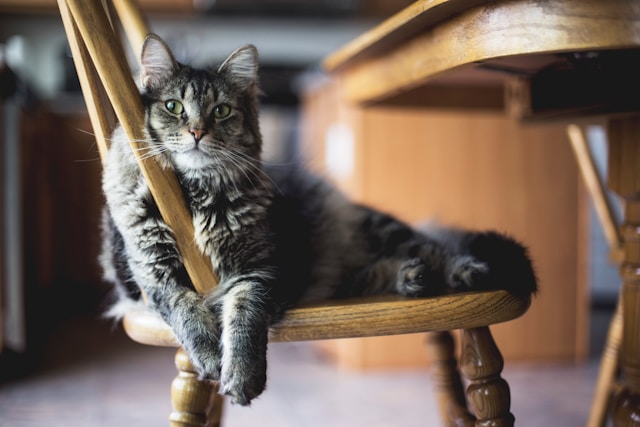If you’ve ever observed a cat, you’ve likely noticed their fascination with boxes. Whether it’s a cardboard shipping box, a paper bag, or even an empty shoe box, many cats are irresistibly drawn to these seemingly mundane objects. This blog explores why cats are so obsessed with boxes, the benefits of box play, and how you can use this knowledge to enrich your cat’s life.
The Science Behind Cats’ Obsession with Boxes
Understanding the reasons behind this behavior involves delving into a mix of feline instincts, environmental factors, and sensory experiences.
1. Natural Instincts
Cats have strong survival instincts inherited from their wild ancestors. Boxes provide a safe, enclosed space that satisfies several of these instincts:
- Safety and Security: In the wild, cats use enclosed spaces to hide from predators and feel secure. Boxes mimic this safe, confined environment, making them appealing to domestic cats.
- Hunting and Stalking: Boxes create an environment where cats can practice their hunting and stalking skills. The enclosed space allows them to ambush toys or even their human companions in a safe, controlled manner.
2. Environmental Enrichment
Boxes offer an enriching environment that stimulates both physical and mental activity:
- Exploration and Curiosity: Cats are naturally curious and love to explore new environments. Boxes provide a novel space for exploration and play.
- Mental Stimulation: The enclosed space of a box encourages problem-solving and creativity as cats figure out how to get in and out or interact with the box.
3. Sensory Appeal
Boxes engage multiple senses for cats:
- Touch and Texture: The texture of cardboard or paper can be intriguing to cats. They enjoy scratching, kneading, or simply feeling the different materials.
- Smell: Boxes often carry scents from their previous contents, which can be stimulating for a cat’s highly developed sense of smell.
- Sound: The crinkling or rustling sounds made by boxes can attract and entertain cats.
The Psychological and Physical Benefits of Box Play
Boxes are more than just a source of amusement for cats. They offer several psychological and physical benefits:
1. Stress Reduction
- Safe Space: A box provides a secure, private space where a cat can retreat from stressors and feel safe. This is especially beneficial in multi-pet households or during changes in the environment.
- Calming Effect: The confined space of a box can have a calming effect, reducing anxiety and helping cats feel more secure.
2. Exercise and Physical Activity
- Play and Exercise: Boxes encourage cats to jump, climb, and explore, which provides physical exercise. This helps maintain a healthy weight and prevents obesity.
- Agility Training: Boxes can be used to create obstacle courses, promoting agility and coordination.
3. Mental Stimulation
- Problem-Solving Skills: Figuring out how to get into or out of a box engages a cat’s problem-solving skills and stimulates their mental faculties.
- Creativity and Exploration: Boxes inspire creative play and exploration, keeping cats mentally sharp and entertained.
How to Maximize the Benefits of Boxes for Your Cat
To fully harness the benefits of box play, consider these tips:
1. Offer a Variety of Boxes
Different types of boxes can provide varied experiences for your cat:
- Cardboard Boxes: Simple and accessible, these are perfect for scratching, hiding, and play.
- Paper Bags: Crinkly paper bags offer additional sensory stimulation and a different texture compared to cardboard.
- Plastic Containers: Large, clean plastic containers can be used as tunnels or hideaways.
2. Create an Enriching Environment
Enhance the box experience with these additions:
- Add Toys: Place toys or treats inside boxes to encourage exploration and play.
- Layer with Bedding: Line boxes with soft bedding or blankets to make them more inviting and comfortable.
- Build a Box Fort: Stack or arrange several boxes to create a multi-level play area or fort.
3. Incorporate Boxes into Playtime
Use boxes as part of interactive play sessions:
- Interactive Games: Use boxes in games of hide and seek or as part of an obstacle course.
- Training: Incorporate boxes into training exercises to reinforce positive behaviors or teach new tricks.
4. Safety Considerations
Ensure that box play remains safe for your cat:
- Monitor for Hazards: Check that boxes are free of staples, tape, or other materials that could be harmful if ingested.
- Size and Stability: Use appropriately sized boxes and ensure they are stable to prevent accidents.
Addressing Common Questions About Cats and Boxes
1. Why does my cat prefer small boxes?
Cats often prefer smaller boxes because they offer a snug, secure environment. The confined space mimics the safety of a den or hiding spot, which makes them feel protected and comfortable.
2. My cat seems to chew on boxes. Is this normal?
Chewing on boxes can be a normal behavior for cats, especially if they are teething or exploring their environment. However, excessive chewing may indicate a need for more stimulation or an underlying issue. Ensure your cat has plenty of toys and consider providing alternatives for chewing, like cat grass or safe chew toys.
3. How often should I replace boxes for my cat?
Replace boxes when they become worn out, dirty, or damaged. Regularly rotating or refreshing boxes can maintain your cat’s interest and ensure a clean and safe play environment.
Conclusion
Cats’ fascination with boxes is a delightful and intriguing aspect of their behavior. By understanding the reasons behind this obsession and leveraging the benefits of box play, you can enhance your cat’s physical and mental well-being. Provide a variety of boxes, create an enriching environment, and incorporate boxes into interactive play to keep your feline friend happy, healthy, and engaged. Embrace their love for boxes and enjoy watching your cat’s playful antics and exploration.











Leave a Reply